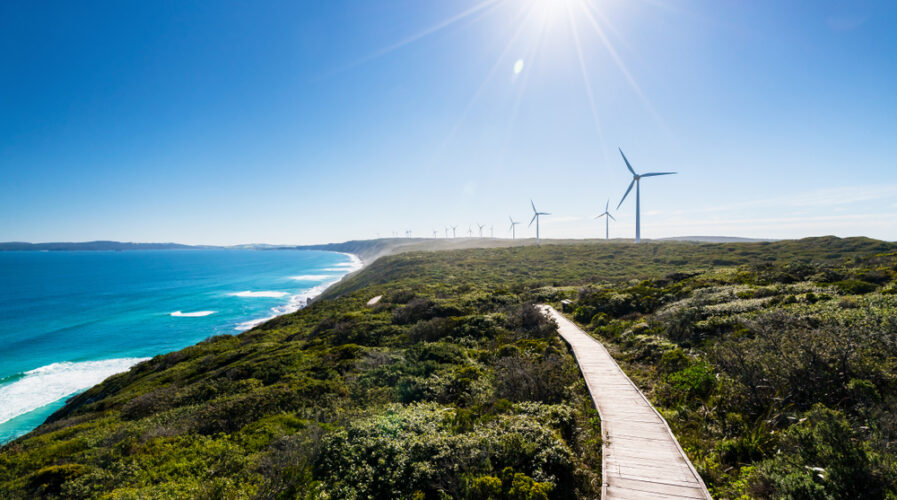
Wind farms are one of the renewable energy sources produced in land-rich Australia. Pictured is the well-known Albany wind farm in Albany, Western Australia. (IMG/Shutterstock)
More renewable energy sources for Australia with ACE Power’s AU$2.5 bil investment
Australia’s push for renewable energy sources this year comes in the wake of legislation to shut down coal factories in the country.
Its vast lands are conducive for the generation of natural, renewable energy sources such as wind and solar energy. About 70% of Australia’s electricity needs are supplied by coal, which makes the space and opportunity for producing renewable energy sources all the more lucrative — and better for the environment.
Australia is one of the world’s heaviest emitters of carbon — on a per capita basis. The country produces approximately 17 tonnes of carbon dioxide emissions yearly. To put those numbers into perspective, it is more than three times the global average of 4.8 tonnes (in 2017).
Last year, the Australian government pumped in AU$1.6 billion for the Australian Renewable Energy Agency (Implementing the Technology Roadmap) Regulations 2021, in a bid to support and develop the renewable energy sector.
In July this year, new rules were developed to support the next generation of low emission energy technologies (LETs).
Despite the lack of a formal net-zero target, Australia is seeing increased investment in the clean energy sector. For every dollar invested in renewable energy sources, 90 cents have gone towards wind and solar power, according to the Australian Energy Market Operator (AEMO). The AEMO runs Australia’s power and gas markets.
Last month, ACE Power came onto the scene, aiming to pump in about AU$2.5 billion of spending by 2024/25 to build wind, solar, battery and storage projects — 10, to be exact.
According to Koovashni Reddy, director of development of ACE, the first four projects ought to reach financial closure by the second half of next year. Recently, their efforts have already succeeded in acquiring 1.3 gigawatts of proposed renewable generation capacity.
Out of the four projects, two solar farms in Victoria and another two in Queensland have already received approval for development, whereas earlier-stage projects are still pending approvals. According to Reddy, all projects are in the process of securing network connections.
Backed by Germany’s Pelion Green Future as the majority investor, ACE Power is the German firm’s first Australian investment. As part of equity arrangements, Pelion would provide crucial development funding for these projects.
They would then translate into listed Pelion entities, according to Reddy. Pelion has a healthy track record of developing green energy in Europe. Unlike Pelion, however, ACE Power appears to be a rather unknown entity, having been formed in April 2021. Checks to their website by Tech Wire Asia have resulted in a static front page with nothing else.
ACE Power’s 10 planned projects were reportedly acquired from a company called CleanGen Projects. Out of these 10 projects, nine are solar farms, with the last being a wind farm. They are to be spread across all the major National Electricity Market states, including Queensland, New South Wales, Victoria, and South Australia.
These movements to procure and produce more renewable energy sources appear to augur well for the country. Efforts by the government, as well as private sector players, are essential to reduce or remove reliance on coal for the country’s energy needs.
The lucrative opportunity for private players in the Australian and regional renewable energy market is highly attractive as well, making it easier for all users of electricity, including households, but more importantly, the industries and commercial sectors that guzzle about 79% of the nation’s electricity, to switch to safer and cleaner energy.
Late last month, Sun Cable’s Australia-Asia PowerLink (AAPowerLink) got the green light from Indonesia to route its network through Indonesia to connect its solar farm in Darwin, Australia, to Singapore.
READ MORE
- The criticality of endpoint management in cybersecurity and operations
- Ethical AI: The renewed importance of safeguarding data and customer privacy in Generative AI applications
- How Japan balances AI-driven opportunities with cybersecurity needs
- Deploying SASE: Benchmarking your approach
- Insurance everywhere all at once: the digital transformation of the APAC insurance industry
